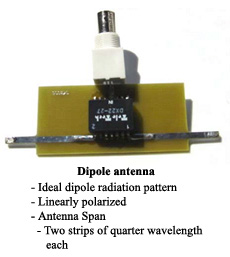|
Illinois Tiny Satellite Initiative |
  |
University of Illinois @ Urbana-Champaign |
|
ITSI |
|
UIUC |
|
|
Satellite
Antenna |
Satellite Antenna

The satellite antenna
is a critical part of the communication system. Without the antenna,
communication between the satellite and the ground station would not be
possible. There are several key components that make up the antenna system:
antenna element, power divider/combiner, and RF circuit board.
The ION will
communicate with the ground station through a dipole antenna. The dipole
antenna's radiating element is composed of cross-curved steel strips, typically
used in tape measure. Two antenna elements of a quarter-wave will realize the
half-wave dipole. The antenna elements will have a 180° phase separation from
each other and exhibit linear polarization.
During the launch of
the satellite, the antenna elements will be tied down along the sides of the
satellite. After the initial release of the satellite into it's orbit, the
computer will switch on current to a loop of metal wire surrounding some nylon
wire, melting through it. The natural tension in the tape-measure stock will
cause it to flip up into the ready position. This only needs to be done once,
and is irreversible.
A power
divider/combiner will be used to balance the power to and from the input and
output ports. It will also shift one of the output ports by 180°, which combines
with the other output port to get a single mixed signal connecting to the
radio.
A microstrip
antenna design is used for signal distribution as a RF waveguide to the antenna
elements or to the radio. It also provides a structural support for mounting
critical components for antenna operation as well as provides a parallel surface
for mounting the steel strips of the antenna elements. The backplane side of the
antenna board will be completely copper clad. The other side will contain line
traces of a designed line width, which will connect the antenna components.

A Circularly
Polarized Yagi Antenna is located on the roof of Everitt Lab on the University
of Illinois' campus. With other equipment to compensate for Doppler shift
and amplification, we are able to communicate with the CubeSat satellite in a
650km (~400m) orbit as it passes over our ground station. The satellite
ground tracks allows for two ten-minute periods of communication, one period at
10:00am and another at 10:00pm.
A ground station
has been set up within Everett Labs to handle communication with the satellite.
The station consists of a computer to control the rotor that points the antennas
on the roof at the satellite which is being tracked, the antennas (70 cm band),
the control for the rotor, and an amateur band HAM radio. A modem can be
connected to the radio in order to transfer data to and from the satellite.
In order for the
station to maintain communication with the satellite, the antenna must be
pointing in the correct direction. The rotor on the roof points the antenna to
the azimuth and elevation coordinates given by the controller inside the
building. A serial connection between the computer and the device which controls
the rotor allows communication and control via the computer.
Software named "SatTrack"
has also been placed onto the computer which takes information on known
satellites, outputting coordinates to a file for use in tracking. There is also
information that will be useful in the calculation of Doppler Shift when we are
sending and receiving information which is provided by SatTrack. Another program
is used to interpret the output of SatTrack and point the antennas according to
that information.
|
|